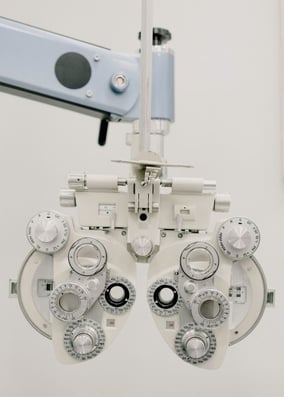
Some optometrists know before graduating that they want to open their own private practice. Others learn this about themselves after working for another optometrist for a while.
Before you take the plunge and go out on your own, there are a lot of factors to think seriously about. It is a big commitment both personally and professionally. You want to be sure opening a cold start optometry practice is really for you.
We offer a two-part series on what you need to know before embarking on a cold start optometry practice.
Part 1 covers the topics:
Part 2 covers the topics:
The first question to ask yourself is, “Why do I want to do this?” For most, it is the freedom that comes with being your own boss. The ability to make your own decisions without needing someone else’s approval. Once you answer the question of why, you can begin planning for your practice. Some suggestions are:
Be prepared to work long hours in the beginning. Your ultimate goal may be to never work on a Saturday or Sunday, but this is generally not realistic for when you begin your practice. You will need to do all you can to generate revenue while the community gets to know you.
Private practice is a lot of work but can be rewarding at the same time. Those who succeed are those who want to be business owners in addition to being optometrists. They want to oversee running their own organization.
An association of other optometrists can provide you with valuable information about how to start your optometry practice, how to choose a location, how to find financing and more. They offer seminars and even have cold start practice programs you can join.
Vision Source, for example, is a strong network of private practice optometrists in North America who support each other. The organization provides its members with everything from start-up guidelines to cost-savings products and even mentors.
Now that you have made the decision to start up your own optometry practice, the next question is, where do you want your practice to be located? There are several factors that go into choosing a location. You want to be in a state and city that you will be happy living in for—well, possibly the rest of your life.
Once you have decided on the broad location, then find a specific location within the city. Some considerations are:
An important aspect of having a successful business of any kind is to have a detailed, comprehensive business plan. This is necessary to obtain financing and to show you have confidence your business will be profitable.
You do not need to have business experience to become knowledgeable about how you want your optometry practice to run. There are books and courses available online. You can attend business classes at a community college. Ask to pick the brain of an experienced optometrist who has had a successful optometry practice for a few years.
As one business professional said, it is pretty simplistic. The basic principle is that you need more money coming in than you have going out. Don’t stand by and watch your practice bleed money without taking action to change course.
You may find it easier to have the assistance of advisors when putting your plan together. The right advisors can help you with finding a location, working with contractors, negotiating your lease, determining the equipment you need, obtaining financing, and more.
Even though your goal is to be your own boss, this does not mean you have to do it all yourself. The wise optometrist assembles a team of advisors such as an attorney and an accountant to assist.
Legal assistance. An attorney can help in many areas. Just a few are:
Accounting assistance. How much help you need in the accounting department depends on your own skills. You may want a monthly service with an accountant who will keep your books up to date.
Some optometrists prefer to do their own accounting and consult with their certified public accountant (CPA) on a quarterly basis. The accountant can handle higher levels of accounting such as the depreciation of equipment and preparation of quarterly and annual tax statements and returns.
Whichever way you choose to go, you should learn:
You need to decide if you plan to purchase commercial real estate or lease space.
Owning your building. New construction, or building out an existing one, is more expensive than leasing but you will more likely get exactly the design you want. If you are leasing space, you may need to do some remodeling. Either way, you will need to work with a construction company.
Working with construction companies. You should meet personally with at least three contractors and get three bids. You want to feel comfortable with the contractor and have a good rapport since you will be working together for a few weeks or months. The time depends on how extensive the construction project is. Make sure the construction company will be in charge of permits.
Leasing space. Renting space is generally less costly and therefore less risky. If you decide to rent, your legal counsel can negotiate lease terms with the landlord. These should include things like:
The lease terms should all be in writing. There should be no ambiguity about the obligations of each party.
No matter how skilled or personable you are, your office needs to be a place where your patients feel welcome and comfortable. Walking in the front door into the waiting room is their first connection with you.
Some suggestions are:

There are basic costs associated with each step of starting your own practice. Some of the main costs include:
The cost of renting or owning. This also includes utilities like electricity, gas, water, etc.
Insurance and licensing. Neither of these are expensive items but still must be included in the annual cost of doing business.
Equipment. Research each piece so you know exactly what the cost of the item will be. Consider buying used equipment from reputable sellers. There are used equipment distributors who refurbish equipment and sell it for substantially less than if you buy it new. Keep in mind that a lot of optometric instruments have not changed in the last few decades, so refurbished equipment should be adequate.
Look for sales or discounts on new equipment. Compare the price of purchase versus leasing equipment. Your accountant will help you determine the tax advantage and liabilities of purchasing versus leasing.
You want your practice to have a successful cash flow as soon as possible. This means you should be sure you need each piece of diagnostic equipment and start off only with the required equipment to begin your practice. That typically includes:
Specialty diagnostic equipment. Depending on the nature of the practice, you may need to add specialty diagnostic equipment.
Inventory if you plan on dispensing glasses and contact lenses. You will need an optical setup and inventory. It is advisable to use one vendor so you can buy at bulk discounts, and to invest in quality instruments that will last for years.
Frame inventory. The scope of your inventory depends on your demographics and mission statement for your practice. The average number of frames for a cold start practice is generally around 400. Consider your demographics when determining:
Technology. This should all be as current as possible and refers to:
Your IT service provider will become your new best friend.
Staff: You need to pay your staff commensurate with pay in your geographic area. Be picky about hiring. You need staff who will follow your script for how you want things done for:
You need to be okay with terminating an employee who does not follow your instructions, seems incompetent, or makes your business and personal life miserable.
Costs of furnishings and miscellaneous decorative items.
Fees for your legal, accounting, marketing, and other members of your advisory team.
Cost of marketing: Have this plan in place prior to opening. You need to include these costs in your request for financing. Focus on the demographic you want to have as patients. Older patients generally prefer print ads. Younger ones look to social media for recommendations.
Unexpected costs. Establish a fund for unexpected costs. Something almost always comes up.
There is a lot to do to open your practice. As one optometrist said about starting her optometry practice cold, “each individual component wasn’t particularly difficult, it’s just that there were a lot of things happening at once.”
You do not have to go it alone. Dental & Medical Counsel has the experience you need in helping you with the details of opening your own optometry practice. We provide a complimentary consultation with attorney Ali Oromchian where he can discuss your needs and how he can help. Contact us today to get started.
To read part 2 of this blog, click here.

Stay updated with industry news!
1904 Olympic Blvd, Suite 240
Walnut Creek, CA 94596
Phone: 925-999-8200
Fax: 925-884-1725
frontdesk@dmcounsel.com
| Monday | 8:00AM - 6:00PM |
| Tuesday | 8:00AM - 6:00PM |
| Wednesday | 8:00AM - 6:00PM |
| Thursday | 8:00AM - 6:00PM |
| Friday | 8:00AM - 6:00PM |
| Saturday | Closed |
| Sunday | Closed |